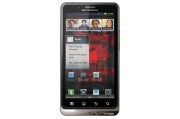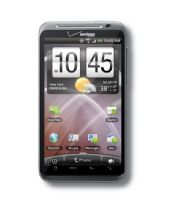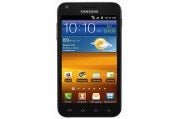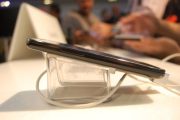Motorola Droid Bionic

Rating
Pros
- Dual-core and Verizon 4G is a speedy combination
- Assortment of entertainment and business features
- HD 1080p video capture
- Lots of compatible accessories
Cons
- Pricey
- Call quality is uneven
- Display disappoints
Bottom Line
The long-awaited Droid Bionic is blazing fast and has a slew of great entertainment and business features, but the high price might make it a hard sell.
Motorola Droid Bionic: Full-Featured, Fast, and Expensive
 It feels as if we’ve waited an eternity (well, about nine months) for theMotorola Droid Bionic ($300 with a two-year contract as of September 7, 2011) to come to Verizon, but the dual-core 4G phone has finally arrived. While you might cringe at the steep price, the dual-core TI OMAP processor paired with Verizon’s superspeedy LTE network makes for one fast phone. But the Bionic falls short in its display and call quality, making that high price tag seem a bit unreasonable.
It feels as if we’ve waited an eternity (well, about nine months) for theMotorola Droid Bionic ($300 with a two-year contract as of September 7, 2011) to come to Verizon, but the dual-core 4G phone has finally arrived. While you might cringe at the steep price, the dual-core TI OMAP processor paired with Verizon’s superspeedy LTE network makes for one fast phone. But the Bionic falls short in its display and call quality, making that high price tag seem a bit unreasonable.
(Editor’s note: We will be lab-testing the Droid Bionic over the next few days, and we will update this review--and possibly the score--depending on the results.)
High-Quality Design, Disappointing Display
When you pick up the Bionic, you’ll immediately notice its high-quality feel and sturdy construction. The dark gray, soft, rubberized battery cover is nice in the hand, and the Corning Gorilla Glass face gives it a sophisticated feel. The Bionic’s design isn’t as fun as that of the Photon 4G (Sprint), which has a futuristic, angular look. It's somewhat blocky, and it feels a little large (though admittedly my hands are a bit small). Measuring 5.00 by 2.63 by 0.43 inches, the Droid Bionic is the slimmest LTE phone on Verizon. It weighs 5.6 ounces, slightly lighter than the Photon.
The 4.3-inch qHD (Quarter High Definition) display isn’t as sharp as we expect a 960-by-540-pixel screen to be. The images I loaded from my Facebook profile looked a little grainy, with a slight bluish tint. I could also see a grid of dots in the image--even without zooming in. Unfortunately, this isn’t the first time we’ve taken issue with a Motorola phone’s display. The Photon also had a slight bluish tint, and the Droid 3’s qHD display suffered from the dots issue. I was impressed, however, with how sharp the text looked in the browser and in Gmail.
Software: Built for Business and Entertainment
Like the Photon 4G and the other hot phones of the fall, the Droid Bionic runs the latest version of Android, 2.3.4 (Gingerbread). It also runs Motorola’s custom-built MotoBlur widgets, including the social networking widget, which aggregates all of your account profiles into a single view on your home screen. The widgets are resizable (à la Android Honeycomb), and you can scroll through them; in the calendar widget, for example, you can scroll through a whole day’s worth of events rather than viewing one event at a time.
Unlike other Motorola phones, though, the Bionic is not tied to the MotoBlur cloud service. Instead, you get an app called ZumoCast, which lets you access remote files on your PC without having to upload or sync your files. You can access everything from PowerPoint files to your iTunes playlists on your Bionic. Even though the Droid Bionic has plenty of storage (1GB of RAM, 16GB of on-board memory, and a preinstalled 16GB MicroSD card), I find it nice to be able to access videos, documents, photos, and other media files without having to download them to the device or upload them to a cloud service.
Performance
The Droid Bionic takes about 43 seconds to turn on fully. Much of that time is consumed by a Verizon Droid logo animation, which plays while the phone is loading. The graphics look neat, but the fact that a phone this powerful takes so long to boot is kind of surprising. Once you’re up and running, operating the phone is smooth sailing throughout. In my tests, flipping through the Bionic’s menus was very fast with no lag or stuttering. The browser loaded Web pages quickly, over Wi-Fi and 4G. Over Verizon’s LTE network, PCWorld.com loaded in 18 seconds, and the image-heavy TheBoldItalic.com loaded in an impressive 8.3 seconds. Over Wi-Fi, PCWorld.com loaded in a speedy 3.3 seconds.
We also tested the phone using Qualcomm's new benchmarking app, Vellamo, just to see how a TI processor would fare against its competitors. The Droid Bionic earned a score of 715, which places it below the HTC Sensation and EVO 3D (both of which are powered by Qualcomm chipsets) but above the Motorola Atrix 4G (which uses an Nvidia Tegra 2 chip). We take these scores with a grain of salt since Qualcomm manufactures the app, but the data is interesting to compare.
Call quality over Verizon’s network was uneven. My friends’ voices sounded hollow and blown out, as if they were talking too close to the speaker. Sometimes I found it hard to understand them, and I had to adjust the volume on almost every call. My friends, on the other hand, were more positive. I made a few of my calls next to a loud generator, but my friends reported that they could not hear it in the background.
We’re still conducting our battery-life tests on the Droid Bionic, so we’ll update with a full report once we’re finished. Battery life with regard to Verizon’s 4G phones has been a hot issue, so we plan on investigating the Droid Bionic’s battery as thoroughly as possible. According to Motorola, the Droid Bionic offers 650 minutes of talk time and 200 hours of standby time, and takes 3.5 hours to obtain a full battery charge. It has the largest battery of all Verizon LTE devices, at 1735 mAh.
Good Camera, Great Gallery
 Like most of the latest and greatest smartphones, the Droid Bionic has an 8-megapixel camera. It can shoot up to 1080p HD video, too; it's the first Verizon LTE phone to be able to do so. When I met with Motorola, I asked the product managers why the Droid Bionic took so long to come to market. Their response? Among other features, 1080p was added to the phone after Motorola's initial CES announcement.
Like most of the latest and greatest smartphones, the Droid Bionic has an 8-megapixel camera. It can shoot up to 1080p HD video, too; it's the first Verizon LTE phone to be able to do so. When I met with Motorola, I asked the product managers why the Droid Bionic took so long to come to market. Their response? Among other features, 1080p was added to the phone after Motorola's initial CES announcement. We've never been blown away by the image quality on Motorola cameras--the white balance tends to be off, giving photos and video a bluish tint. The Photon’s camera was slightly better than those of other Motorola phones, such as the Droid 3 and the Triumph, so I had rather high expectations for the Bionic’s camera. Thankfully, it met my expectations: Although the Droid Bionic’s camera isn’t the best I’ve seen (that honor goes to the T-Mobile MyTouch 4G Slide), I was pleased with the sharpness, color accuracy, and brightness of my indoor and outdoor photos.
We've never been blown away by the image quality on Motorola cameras--the white balance tends to be off, giving photos and video a bluish tint. The Photon’s camera was slightly better than those of other Motorola phones, such as the Droid 3 and the Triumph, so I had rather high expectations for the Bionic’s camera. Thankfully, it met my expectations: Although the Droid Bionic’s camera isn’t the best I’ve seen (that honor goes to the T-Mobile MyTouch 4G Slide), I was pleased with the sharpness, color accuracy, and brightness of my indoor and outdoor photos.
Video capture was quite good. The Droid Bionic’s camera handled action without any pixelation or artifacting. Color looked good, and the microphone did a good job of handling audio.
The enhanced gallery displays photos from your own library, in online libraries (Facebook, Flickr, Photobucket, and finally Picasa), or in your friends' libraries on assorted social networks and on DLNA servers.
Accessories Galore
Like the Photon and the Atrix, the Droid Bionic can hook up to a special dock that lets you access your phone in “webtop” mode. When you connect to the webtop dock, you can access the full Firefox browser as well as a slew of specially made productivity apps. Certain apps (such as Angry Birds) can run at full screen on a larger display. The Droid Bionic has all sorts of accessories available for it, including the Motorola Lapdock ($300, like the one that was advertised with the Atrix), a standard dock ($40), a vehicle navigation dock ($40), and an HD station ($100). We’ll be taking a closer look at the accessories in the next few days, so stay tuned.
Bottom Line
Although we’re still wrapping up our lab tests of the Droid Bionic, it is safe to say that this is one of Verizon’s strongest phones available right now. The build quality is excellent, the software is clean and intuitive, and the addition of ZumoCast is terrific. The display, however, is a big disappointment. The overall speed of the Droid Bionic is almost enough to make up for that shortcoming, but the high price makes the phone a tough sell. On the plus side, if you’re upgrading from a basic handset or feature phone to the Bionic, you’ll get a $100 gift card toward your Verizon bill or any accessories. That’s a good incentive, but it seems like a big leap to go from a phone that can only make calls to this dual-core, 4G beast. It might be more fair to extend such an offer to 3G Droid owners or, at the very least, to owners of the original Droid.
HTC ThunderBolt

Rating
Pros
- Extremely fast
- Latest Sense UI
Cons
- Lots of bloatware
Bottom Line
The well-appointed ThunderBolt is the phone to buy if you want to see what 4G can do.
Verizon ThunderBolt Review: Real 4G Speed Comes to the Smartphone
The HTC ThunderBolt, which went on sale March 17, is the first phone available in the United States that can connect to Verizon’s lightning-fast 4G LTE network. That fact alone makes the ThunderBolt ($250 with a new two-year contract) a considerable piece of hardware, especially for users who routinely run high-bandwidth apps such as video chat, online gaming, and high-definition video streaming. Network speed aside, I found the phone itself to be another solid addition to HTC’s mostly impressive family of smartphones, albeit one with a few shortcomings.
Handsome Design
 The ThunderBolt definitely feels well built and sturdy in the hand. However, for someone coming from a smaller phone, the 5.78-ounce ThunderBolt, with its 4.8-by-2.6-by-0.52-inch frame, can feel like a monster in comparison.
The ThunderBolt definitely feels well built and sturdy in the hand. However, for someone coming from a smaller phone, the 5.78-ounce ThunderBolt, with its 4.8-by-2.6-by-0.52-inch frame, can feel like a monster in comparison.
But the phone makes good use of its size. The ThunderBolt’s 4.3-inch WVGA screen gives you ample room to maneuver your fingers while touch-typing and navigating Websites when you’re on the go. My one complaint about the screen is that it is difficult to see outside under direct sunlight.
The phone's design is quite simple, offering a power button and a headphone jack up top, a volume rocker on the right spine, and the standard Home, Menu, Back, and Search buttons on the face of the device. On the back are an 8-megapixel camera (with a dual-LED flash) and a kickstand, much as we saw on the HTC EVO 4G. You'll also find a 1.3-megapixel camera on the front of the device for video chatting (more on that farther down).
Lightning-Fast Broadband Speeds
The ThunderBolt’s main draw is its broadband speeds, which in my tests were simply stunning. Using the Ookla FCC Mobile Broadband Test, I saw consistent download speeds of between 8 megabits per second and 12 mbps. With full bars and in an area that supports Verizon’s 4G LTE network, I managed to load the PCWorld mobile site in about 4 seconds. Image-heavy sites such as Escapistmagazine.com loaded in under 10 seconds.
The ThunderBolt can share its 4G connection with eight devices via its mobile hotspot function (though the service can cost extra depending on your plan). To test the limits of the 4G connection, I set up such a hotspot and connected an iPod Touch and another smartphone with it. I was able to stream live TV to the iPod Touch, as well as to download apps and watch high-quality YouTube videos on the phone, while at the same time browsing the Web and downloading apps on the ThunderBolt. All of these tasks ran quickly and smoothly over Verizon’s LTE service, and I got the feeling that I could have connected a few more devices to the hotspot with little performance loss.
Call quality on the ThunderBolt was not crystal clear, but it was close. The people I called said they could hear minor wind noise from my end, but no other interference.
HTC Sense Gets a Face-Lift
The ThunderBolt comes preloaded with a new and improved version of Sense UI, HTC’s custom software that overlays the Android OS. Although most of the Sense UI improvements seem merely cosmetic, HTC has thrown in a few nifty new features as well.
For instance, dragging down the notification bar at the top of the screen now reveals a list of previously opened apps. This extremely useful function may have been inspired by a similar feature in Apple’s iOS.
Turning on the fast-boot option will allow you to start the phone almost immediately, though you will have to turn the function off to use certain Android Market apps.
The '+' icon on the right side of the dock (at the bottom of the home screen) has been replaced with a brush and palette. Tapping it brings you to the personalization menu, where you can set the wallpaper, add items to the home screen, and change the sound settings. You can also change the skin of the Sense UI to one of the five available options.
Android Add-Ons
Unfortunately the ThunderBolt also comes loaded with too much unwanted software. Along with the Blockbuster app we saw on the Motorola Droid X, Verizon has loaded the ThunderBolt with a demo of Let’s Golf 2 and videos advertising Bitbop, Rhapsody, and Rock Band for Android. The usual Verizon suite of apps (Navigator, Slacker, V Cast Media, and the V Cast App Store) also makes an appearance. And guess what? You can’t remove these apps. This is not a major negative, but the extra apps do clutter up your app drawer, making it hard to quickly locate the app you want.
Cameras Are a Mixed Bag
The ThunderBolt features two cameras: a 1.3-megapixel camera on the front and an 8-megapixel one on the rear. Pictures that I took with the 8-megapixel camera came out well (click the thumbnails at left to see full-size images). The photos were surprisingly sharp. Even when I zoomed in, the resolution was reasonably good. Colors looked robust and true to the subject of my photos. Pictures taken in extremely low light were clear and easy to see, thanks in part to the dual-LED flash. The HTC EVO 4G also has an 8-megapixel camera on the back, but the ThunderBolt’s camera is clearly superior.
The ThunderBolt’s front-facing 1.3-megapixel camera is another story; pictures that I took with it came out dark and a little murky. The front-facing camera is meant for video-chatting services, but I couldn’t find such an app that would work on the phone. Skype for Android does not yet support video chat, and Fring doesn’t recognize the camera at all.Qik could be another option, but it does not yet provide a video-calling app for the ThunderBolt. Although it’s nice to see more Android phones with front-facing cameras, without any software to use them they’re not much good.
The video I shot with the phone was reasonably clear, but certainly not as clear as the still images I captured. When I shot a moving image, the video seemed a bit fuzzy; only when I held the camera still in front of an object did the sharpness of the video improve. A more serious problem relates to the audio: In video mode the phone records sound at such a low level that you have to turn the volume all the way up to hear it on playback, and even then you can hear only the loudest sounds.
Plays Nice With Other Devices
A DLNA (Digital Living Network Alliance)-certified device, the ThunderBolt can stream photos, music, and video to and from DLNA-supporting devices on your home wireless network. For instance, you can stream video to your DLNA-certified TV for playback. The music player can also stream from any media servers you have on your network.
If you like to listen to your music on the go (as most people do), you’ll be quite happy to learn that the ThunderBolt ships with a 32GB MicroSD card on board so you can carry several thousand songs or movies with you.
Bottom Line
The HTC ThunderBolt looks, feels, and handles like a solid piece of hardware. Although its specs aren’t anything we haven’t already seen in the Droid X or the Droid 2, the ThunderBolt’s ability to utilize the unprecedented speed of Verizon’s LTE network makes it a special phone indeed. Users who like to run high-bandwidth apps on the road--as in streaming high-def video or playing online games--will find no faster phone on the market right now.
Samsung Epic Touch 4G

Rating
Pros
- Bright, clear Super AMOLED Plus display
- Superb performance
- Excellent camera
Cons
- Lots of bloatware/preloaded apps
- Plasticky build
Bottom Line
The slim and speedy Samsung Epic Touch 4G is excellent for gaming, Web browsing and watching video, but the plasticky design feels a bit on the cheap side.
Samsung Epic Touch 4G for Sprint: Slim and Speedy
 The arrival of Samsung's Galaxy S II phones has been a long time coming. We first saw the next generation of Samsung's popular line of Android phones back in February at Mobile World Congress. After many successful months in Europe, the Galaxy S II line of phones is finally coming to U.S. shores. The first of the phones, the Samsung Epic Touch 4G ($200 with a two-year contract with Sprint; price as of September 12, 2011) will be available starting on September 16.
The arrival of Samsung's Galaxy S II phones has been a long time coming. We first saw the next generation of Samsung's popular line of Android phones back in February at Mobile World Congress. After many successful months in Europe, the Galaxy S II line of phones is finally coming to U.S. shores. The first of the phones, the Samsung Epic Touch 4G ($200 with a two-year contract with Sprint; price as of September 12, 2011) will be available starting on September 16.
Ridiculously Thin
 The Epic Touch might be a bit larger than the previous generation of phones, but it is incredibly thin. Measuring 5.1 inches by 2.7 inches by 0.38 inch, the Touch feels pretty comfortable in hand--and this is coming from somebody with small hands! Samsung phones have a bit of a reputation for being plasticky, and the Epic Touch unfortunately falls under that descriptor. In her hands on of the Epic Touch at Samsung's launch even, my colleague Melanie Pinola remarked that it felt “less refined” than AT&T's Galaxy S II version.
The Epic Touch might be a bit larger than the previous generation of phones, but it is incredibly thin. Measuring 5.1 inches by 2.7 inches by 0.38 inch, the Touch feels pretty comfortable in hand--and this is coming from somebody with small hands! Samsung phones have a bit of a reputation for being plasticky, and the Epic Touch unfortunately falls under that descriptor. In her hands on of the Epic Touch at Samsung's launch even, my colleague Melanie Pinola remarked that it felt “less refined” than AT&T's Galaxy S II version.
On the bottom of the phone, you'll find the MHL port, a feature we've seen on many of this year's high-end smartphones. The MHL specification, which stands for Mobile High Definition Link, is a 1080p HD video and digital audio interface for connecting smartphones and other portable devices (tablets, cameras, and the like) to HDTVs. So what's the big deal? It simultaneously provides power to your phone--something that HDMI cables don't do.
Super AMOLED Plus Display
The 4.52-inch Super AMOLED Plus display on the Epic Touch is quite nice, but text isn't quite as sharp as what we saw on the European Galaxy S II. The Epic Touch's display is slightly larger than the European version (which has a 4.3-inch display) so it seems like the text sharpness may have been compromised by larger screen real estate. The text is still quite readable, but it is something I noticed right away upon using the phone.
Otherwise, the display's colors looked bright, details were crisp, and the viewing angles were very good. Blacks were deep, and colors were richly saturated without being overdone. Even when held in direct sunlight, the Galaxy S II's display remained incredibly visible. Whites had a bit of a bluish tint, but it wasn't too noticeable. According to Samsung, Super AMOLED Plus displays have 50 percent more subpixels than the first-generation Super AMOLED displays (seen on the Vibrant, Mesmerize, and other Galaxy S phones) and perform even better than their predecessors in bright light.
Android Gingerbread With TouchWiz 4.0
The revamped TouchWiz 4.0 is fairly similar to the previous version, but it has a few aesthetic and functional enhancements here and there. For instance, the new lock screen displays missed calls and unread text messages; you can swipe these notifications rather than having to unlock your phone and then dig through menus to find the missed messages. The Galaxy S II's keyboard isn't the native Android one, but it retains the multitouch key-chording feature (you can simultaneously press Shift and a letter to produce a symbol or number--no need to switch between modes) and the ability to use your voice to correct words as you type.
Taking a page from (or directly ripping off) HTC Sense, TouchWiz lets you pinch your homescreen to see thumbnail-size versions of all of your screens. Samsung borrowed another feature from HTC Sense, too: When the phone is ringing or playing music, you can silence it by flipping it face-down on a surface.
Contacts gets some cool new gesture-based functions. Swipe right on a friend's name, and you'll start a call with them; swipe left on their name, and you'll jump to the SMS composer, which you can use to send them a text message. Each of your contact's cards comes with your communication history--for example, when you last called, texted, or emailed the person.
One funny new feature is the ability to reject a call by sending a text message. Let's say that your brother is calling to ask when you're going to pay him back for dinner the other night. A menu will come up giving you the option to answer the call, hang up, or reject it with a text that says "I'll pay you back tomorrow!"
All of the Galaxy S II phones have six-axis motion sensing, powered by an accelerometer and a gyroscope. This feature is great for gaming, but Samsung also throws in some gesture-based phone controls. For example, you can zoom in and out of images in your gallery or in the browser by tilting the phone. This feature feels a bit awkward and unnecessary, however; I can't see myself ever using it.
TouchWiz isn't for everyone, so be sure to spend some time with it before purchasing a Galaxy S II phone.
Multimedia and Apps
Because this is a Sprint phone, you'll find all of the usual bloatware: Sprint Music Plus, Sprint Radio, Sprint TV and Movies, and Sprint NASCAR. You also get a game called N.O.V.A. HD and various apps--including Samsung's AllShare app for sharing media over DLNA servers.
Perhaps the coolest app Samsung provides on the phone (and on all Galaxy S II phones we've seen) is the company's own Kies Air. The app lets you view call logs, videos, photos, bookmarks, and IMs, and send SMS messages from PC. In order for the app to work, you'll have to install it on your PC and connect it to the same Wi-Fi network as your phone.
Like all Galaxy phones, the S II provides the Media Hub for movie and TV-watching. Video looked fantastic on the handset's display and played back smoothly. Even if you don't like Samsung's Media Hub, you'll want to watch a lot of movies and TV shows on this phone. Unlike the European version, the Epic Touch 4G does not have the Readers or Music Hub for purchasing ebooks or MP3s, respectively.
Performance
Like the AT&T Galaxy S phone, the Epic Touch is powered by a 1.20GHz dual-core Samsung Exynos processor. The Epic Touch booted up in 20 seconds, which is pretty fast; in contrast, the Droid Bionictook 43 seconds to turn on fully.
We also tested the phone using Qualcomm's new benchmarking app, Vellamo, to see how a Samsung processor would fare against its competitors. The Samsung Epic Touch 4G earned a very impressive score of 914, putting it right behind the Galaxy Tab 10.1 for overall performance and ahead of two phones running Qualcomm chips--the HTC Sensation 4G and the HTC EVO 3D. You should take these results with a grain of salt, since Qualcomm manufactures the app, but the data is interesting to compare.
I experienced reliably good Sprint WiMax 4G coverage in San Francisco. I had a strong 4G signal pretty much everywhere I went in the city. Sprint's 4G network paired with the Samsung Exynos dual-core processor makes for some excellent Web browsing, too. Over 4G, PCWorld.com (the full site) loaded in a speedy 12.1 seconds. Image-heavy site TheBoldItalic.com loaded in 10.1 seconds, and media-heavy ThrasherMagazine.com loaded in 13.6 seconds.
Of course, 4G coverage and signal strength vary depending on where you live in the country and whether your city even offers 4G. We have good 4G coverage in San Francisco; but in our 4G Phone Shootout, Sprint had the poorest country-wide coverage.
Call quality over Sprint was very good overall. My friends and family said that they could hear my voice perfectly and described it as sounding natural.
Superb 8-Megapixel Camera
When we reviewed the European version of the Galaxy S II, we were impressed by its 8-megapixel camera. Luckily, Samsung seems not to have changed the sensor for the U.S. versions. The Epic Touch took excellent photos indoors and out. My only complaint is that colors in my indoor photos looked a bit oversaturated. Details were quite sharp and I didn't detect any graininess or pixelation. The shutter speed on the camera was fast enough to capture photos of sports, kids, and other quick-moving subjects. Again, I must lament the lack of a physical shutter button, but the camera's quality makes up for it.
Like the Motorola Photon 4G, HTC Sensation 4G, and the LG Optimus 3D, the Epic Touch 4G supports up to 1080p HD video capture. Video quality was good: The Epic Touch could handle fast-moving cars and slower-moving people without distortion or pixelation.
Bottom Line
We'll be conducting formal lab testing over the next few days, but right now, it looks as though the Epic Touch 4G is the fastest Android smartphone out there. On top of its speediness, it has a superslim design, a gorgeous display, and a superb camera. My only complaint is the amount of carrier and manufacturer-added bloatware on the phone, but that's pretty much par for the course these days.




No comments:
Post a Comment